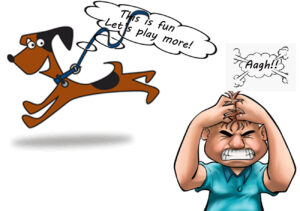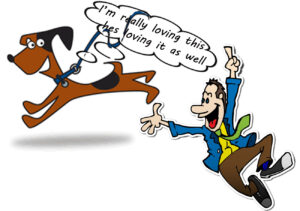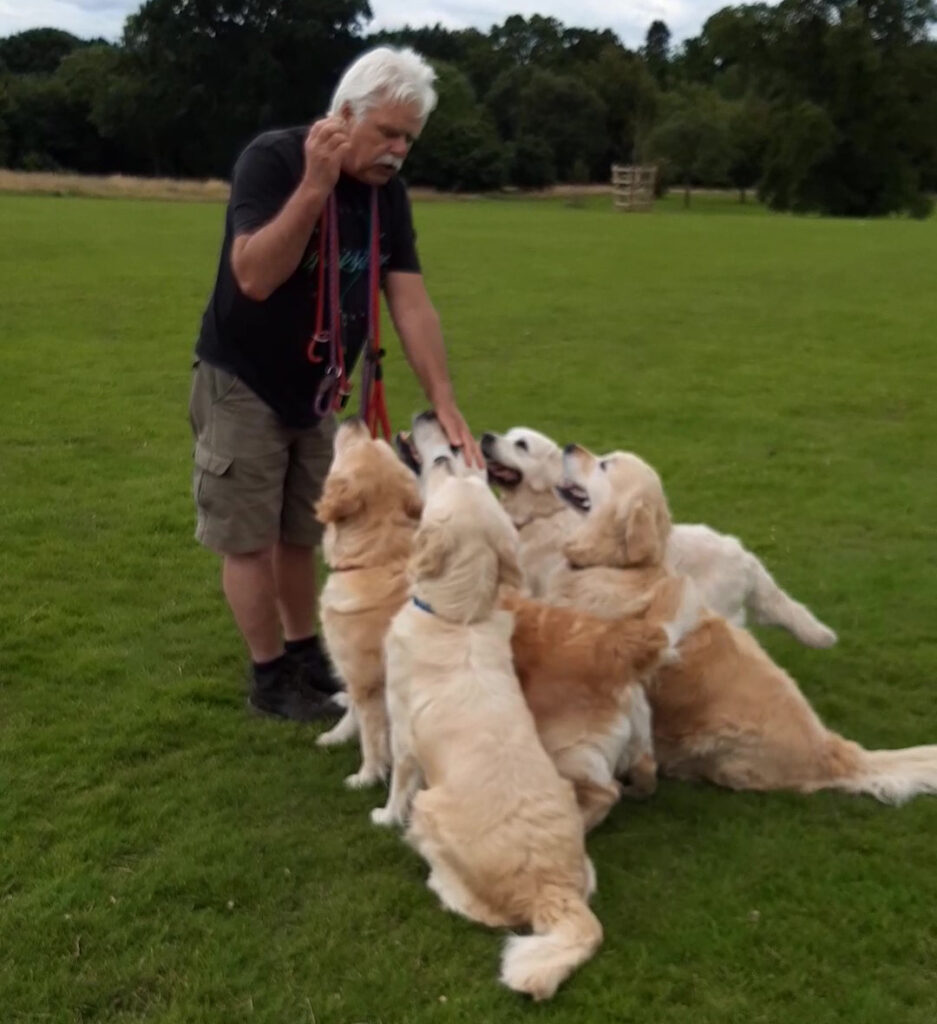Well socialised and trained dogs – is that your dog?
We’ve all seen it happen and in truth if your a dog owner you’ll have (hopefully not very often!) been victim of it at some point! Your dog is straining on the lead trying to get to something that you don’t want them to or, it’s run off doing it’s own thing ignoring all your attempts which can get increasingly desperate, to get it back in control!
Having your own or, interacting with other well socialised, well trained, obedient dogs is a real pleasure. On or off lead walks are relaxed, stress free and enjoyed by both you and your dog. You can have fun together without having to constantly be worried that it will go pear shaped!
The alternative is a dog owner constantly yanking on the lead or being dragged along by a large dog or chasing after their pooch hollering and getting more and more agitated and embarrassed by events. Not good for the owner or indeed the dog that will often be on the receiving end of an angry owner telling them off and the dog looking thoroughly confused and miserable!
Let’s consider two aspects that combined help develop a well trained obedient dog.
Socialising –
This is not just about your dog learning to interact with other dogs in a friendly way it’s a lot more and really should be done at the puppy stage.
The world we live in, shops, busy streets with lots of people and traffic, parks with loads of people young and old playing, countryside, farm animals, etc. etc. is the world we expect our dogs to be happy and at ease in. We need to let our puppies explore as much of this world of ours as possible whilst ensuring they feel safe and without making them fearful.
I remember the first time one of our Golden Retriever Barley first encountered a cow close up. We were out walking in the countryside on a narrow path between fields and a burn. Barley was a little bit ahead of us and suddenly stopped dead in her tracks and sat back on her haunches! She had come round a bend a was staring straight at a cow with its head over the fence. Well needles to say the cow was cool about it but Barley wasn’t! She turned and came running straight back to us looking for reassurance! We put a lead on her and walked her slowly up to the cow. She was leaning in to my leg the whole time but as we stopped by it and she realised we were ok with the cow she started to relax and eventually leaned forward for a sniff.
When we walked back past the fields latter on she was as right as rain. She saw the cows, stopped and had a look then carried on quite happy.
Puppies are inquisitive and want to explore so give them the opportunities and they will learn that unexpected things are quite ok. Just be aware of their demeanour and don’t push a situation if they appear fearful. You can always try another time.
Stick with it and before you know it you’ll have well trained and socialised dogs that are confident and friendly.
Training –
Training is easy and training is hard! Sounds a bit confused doesn’t it!
Training is fairly straight forward and you can adopt many methods such as voice commands, whistle, clicker and hand or combinations of these.
The hard part of training is it can at times go wrong and it is never finished! Now that doesn’t mean you have to be continually adding new tricks or commands to your dogs repertoire! What I mean is you need to continually reinforce the training revisiting it regularly. 
The keys to training I think are consistency, kindness, fun, positive reinforcement, and when required firmness.
Consistency – this can be thought of in a couple of ways.
Firstly when it comes to commands make sure everyone in the family using exactly the same commands.
Why make life complicated for your dog by having different commands for the same request? Get everyone using the same commands!
Secondly and in all truth more difficult to achieve, try to be consistent in what you expect from your dog and how you expect it to behave in any given situation. For example if you want your dog to stay down stairs then don’t let them go upstairs. Life will get confusing for your dog if one day he can do something and next day they can’t!
Be kind to your dog. Yes it can be frustrating when things are not working they way you wanted or expected. Take a break play a game with your dog then try again or try a different approach.
Have fun with your dog. If your not enjoying working with your dog to train it then your dog may sense this and be confused. Your dog will train far easier if you’re both having fun so introduce games & play in to their training.
Positive reinforcement – most professional dog trainers (I’m not one by the way) would I think these days would support ‘positive reinforcement’ as the best method to use for training.
This technique is about rewarding your dog with something they really like when they’ve done the thing you wanted them to do.
I do good then nice things happen for me! I gotta do more good stuff!
The reward you give your dog can be but doesn’t have to be food. For example our dogs love being groomed – that intense 1 on 1 fussing! that can be used as reward. A special toy they only get to play with when training could be another. Just figure out what works best for your dog.
Getting the reward timing right is important. It needs to happen very soon after they’ve done good otherwise the association between what was done right and reward won’t be as strong.
Also once a trained behaviour to a command has been learnt and is well established you can change the reward given.
Firmness – This does not mean punishing your dog i.e screaming at it or hitting it! In my view hitting your dog is absolutely the wrong thing to do despite how frustrated we might get.
Firmness is about establishing the rules and boundaries and then being consistent and sticking to them.
Think about the rules or boundaries you want to establish and what the consequences of non compliance are.
For example our current two dogs love to bounce around and bark excitedly to let us know they think its feeding time and I have to say they’re pretty good time keepers!
I don’t mind them barking to let me know but once I start getting things sorted for them I don’t want them bouncing around barking constantly until their bowls are on the ground!
They know this and generally will sit and watch quietly while I prep their food. The consequence of them not sitting quietly is I stop prepping their meal and simply stare at them! They very quickly get the message and peace descends.
Don’t bully your dog simply be firm and consistent with your rules and boundaries and your dog will be happy and live in a world without confusion!
All of the above might sound like common sense and indeed it mostly is. However if you’ve never trained a dog before the whole prospect can seem quite challenging.
Don’t let it overwhelm you –
- make a plan
- decide on rules and boundaries
- decide what voice commands your going to use
- get started and keep going
- Use positive reinforcement not punishment
- Make sure you and your dog have fun

Before you know it you’ll have well socialised and trained dogs.
Final thoughts for this post –
If like us you like to let your dog or dogs run free in wide open spaces and woodland then I would suggest you train to both verbal commands and the whistle.
If your dog is a fair way out or you can’t see them in woodland then using the whistle is better than going hoarse trying to get them to hear your voice commands!
We’ll be putting a post up in the future about dog whistles and training them to it so if your interested check back here with us from time to time.
Oh and if your interested in reading more about ‘Positive Reinforcement Training then there is a good article by the Dogs Trust. You can read it by following this link – Training with rewards: Positive reinforcement

